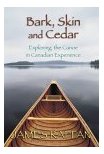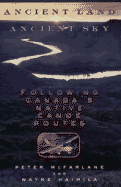Canoeing Book

by James Raffan,
ISBN: 0002557304
Ancient Land, Ancient Sky

by P. Bor McFarlane,
ISBN: 0676971474
The Canoe In Canadian Cultures

by John Jennings And Bruce W. Hodgin
300 pages,
ISBN: 1896219489
Post Your Opinion | | Canonizing Canada’S Canoe
by Brian BrettForget the maple leaf and the beaver. If any symbol binds this country, it’s the canoe. Common from coast to coast when the Europeans arrived, it knitted the threads of the nation’s rivers and lakes and straits together long before the railroad came along. Perhaps Bill Mason, the legendary canoeist, said it best: “It is as if God made the canoe and then set about creating a country in which it could flourish. That country was Canada.”
Unlike many other early modes of transportation, the canoe didn’t become extinct. Instead, it took on a new life as a recreational tool, and often as a spiritual experience, blending into the great wilderness and the ecological ethos that has sprung up in the last thirty years. The three books reviewed here explore this versatile craft and its history in unique ways.
The Canoe in Canadian Cultures is a collection of essays that had their roots in a conference on canoeing sponsored by the Frost Centre for Canadian Heritage and the Canadian Canoe Museum. Alas, the book reads like a conference, complete with the long boring bits. There are papers on traditional birch bark building history, the Tao of paddling, great canoeists, and the evolution of kayak design. Several of the essays are cliquish, assuming the readers know all the arcane lore and physics of canoe ribs or whitewater expeditions by long-dead individuals. Also included are classic examples of bad academia, utilizing a few surviving tidbits of information (often repeated interminably) and pages of jargon to write what could be said in a few words; others dive so deeply into the well of political correctness that they surface with ghastly mouthfuls like “steerspersons”. (There has got to be a better word!)
Bill Mason, the enthusiastic canoeist whose famous book, The Path of the Paddle, and seminal film, Paddle to the Sea, were key to the canonization of the canoe by its aficionados, is treated like a god, and almost one can hear his name spoken in a venerating, whispered tone by the speakers at the conference.
Nevertheless, curiously fascinating little patches of information surface, and I was especially pleased to find a celebration of the author, R.M. Patterson, noted for such classic texts as The Dangerous River.
Recommended only for those who sleep with their paddles and make their own kayaks.
Bark, Skin and Cedar: Exploring the Canoe in Canadian Experience is more a series of elegant essays on different aspects of the construction and history of canoes than an overview. It dwells on subjects as diverse as the “uncanoe” (the York boat), wilderness camps, and the story of Glooscap and his stone canoe. Unfortunately, while it dwells extensively on eastern canoe mythology, it completely ignores the great canoe legends of the west coast First Nations.
James Raffan is the author of the well-received Fire In The Bones, a biography of Bill Mason, and he also has an essay on Mason in The Canoe in Canadian Cultures. A lyric delight, especially in its recounting of canoeing legends, the book is marred by bad copy-editing on occasion. Phrases are repeated, weird spellings such as “knarled” appear, references don’t refer, and once in a while the author makes odd, loopy pronouncements that any good editor should have questioned. There are not many mistakes, but they are irritating when they surface.
Also, Raffan has a tendency to wander. A chapter on the Lachine rapids begins with their description, meanders into voyageur canoe designs, followed by the dinner menu at the Beaver Club, through a modern day reenactment of a voyageur journey, and ends up with a Stan Rogers song. This might sound horrifyingly confusing, but he actually pulls it together, except for a feel-good passage describing how the voyageur reenactment would give its participants empowerment, consensus, commitment, etc.—all the usual modern patter that would send a real voyageur directly to the rum.
The author also assumes the reader has some knowledge of boat construction and canoeing history, and I suspect there are a few passages that would leave the average reader hopelessly confused. Still, Raffan’s knowledge and lyric skills make up for these few flaws. Overall, the book is a charming and informational read.
Ancient Land, Ancient Sky: Following Canada’s Native Canoe Routes by Peter McFarlane and Wayne Haimila is definitely an overview. In their flying canoe, a Cessna 172, the authors trace a route across Canada from St. Anthony in Newfoundland to Nootka Sound in British Columbia. A chatty memoir that also feeds the reader great dollops of history, this is the most readable of the three books. Fun, amusing, and breezy, it loops across Canada, landing like a dragonfly on many of the historic hot spots in the story of the nation’s origin.
The authors have a tendency to use that increasingly familiar “ugly white explorers/colonists meet brave good First Nations people” slant (considering some of the tragic tales being narrated, their outrage is, of course, understandable); but they do have the sharpest noses for history in any book I’ve read in a while. This book is blessed with the knack of telling a lot of story in very few lines. For instance, they give one of the best brief analyses of the growth and collapse of the Algonquin empire that I have ever read, identifying the historic movements of the various tribes and peoples succinctly—and they make it exciting, too!
The narrative is often choppy, like a few of the landings on out-of-the-way airports; yet that is part of its charm. Perhaps its only failing is the centralist vision. Newfoundland is discussed in some detail, but poor old British Columbia is only worth a couple of nights, and the great coast with its major cultures is ignored. The Nuu-chah-nulth only get a fly past—the Haida, the Kwakiulth, and the many other great nations not even that.
Being from the West Coast, I’ve gotten used to the mind set of central Canadian writers, but Haimila actually works in the West, so it is hard to figure. Maybe it annoyed me because the book performs such a wonderful narrative while traversing the rest of the country that I couldn’t help feeling short-changed by the rather abrupt tour of the west. I wanted the book to go on for another 100 pages.
All in all, this is a fascinating collection of books. The canoe and its history is very much alive in Canada. It’s enough to make me want to break out the paddles and go for one last ride on the water before winter is fully upon us again.
Brian Brett lives on Saltspring Island, and is the author of several books of fiction and poetry. His latest is The Colour Of Bones In A Stream. He broke his first canoe in half after going over a waterfall on the Queen Charlotte Islands in 1974.
|